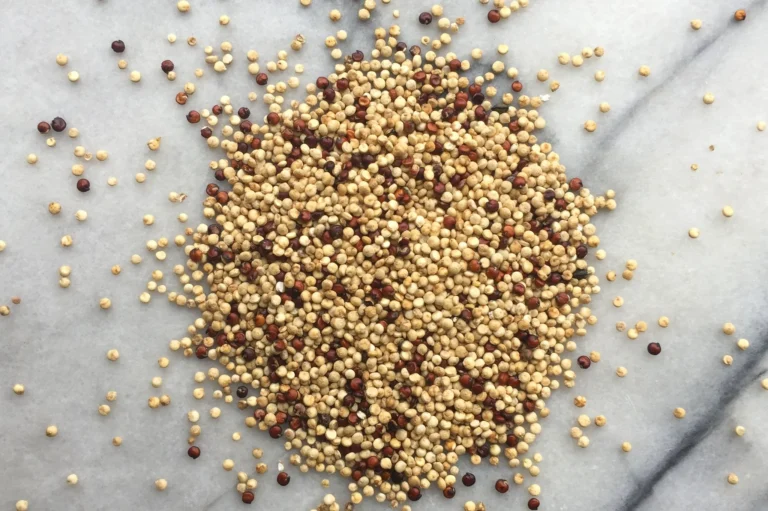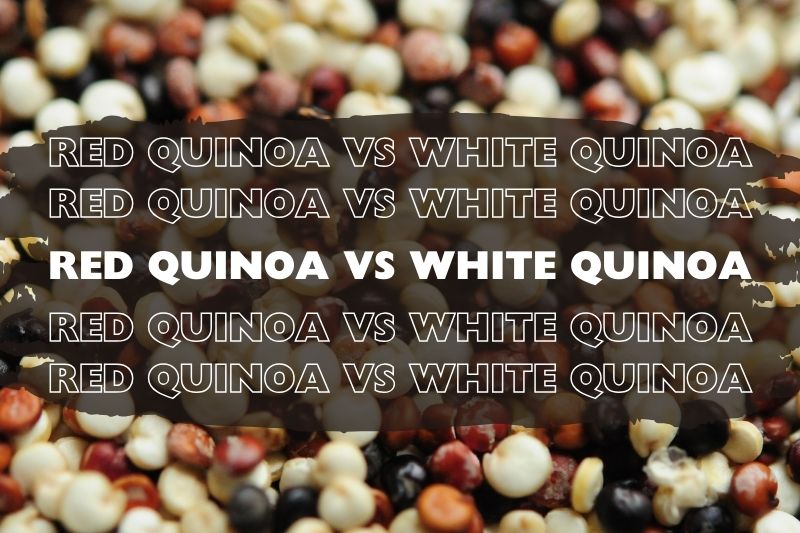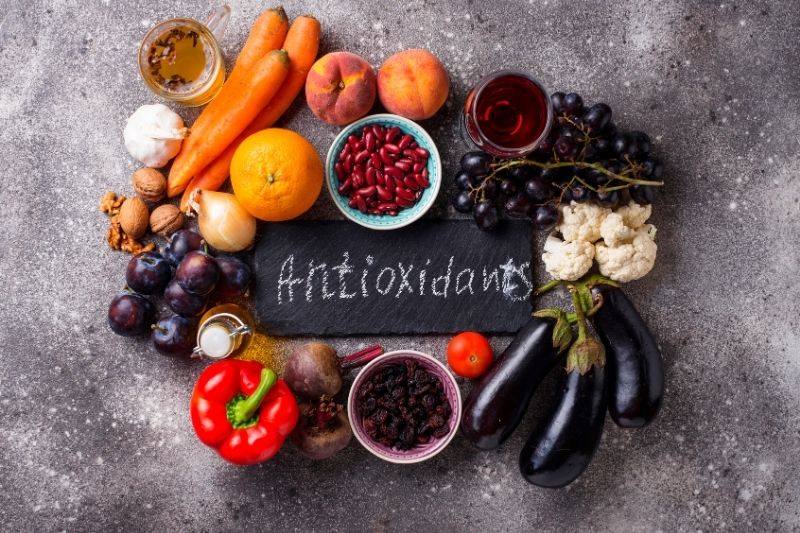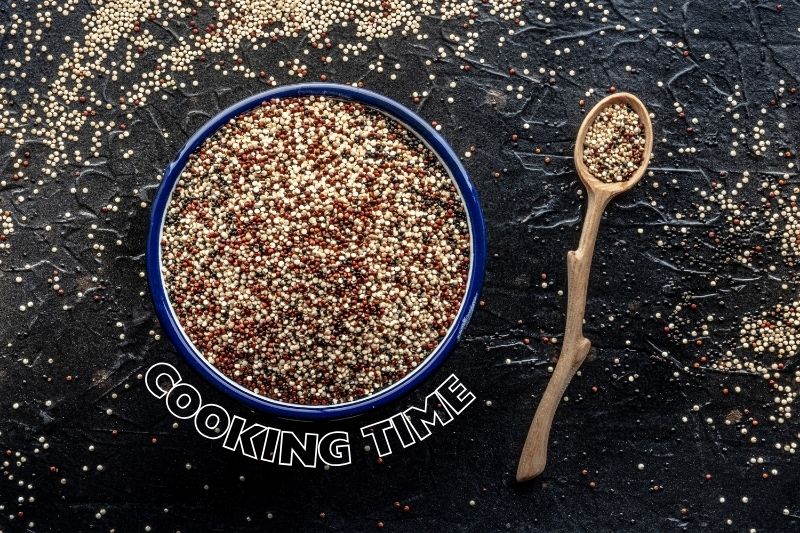When choosing grains for a healthy diet, many people turn to quinoa for its rich nutritional profile. Two popular types, red and white, offer unique benefits and uses. Understanding the differences between them can help you decide which is best for your meals.
This article provides a detailed comparison, covering their nutritional content, cooking properties, and culinary applications.
Red Quinoa vs White Quinoa Basic Comparison
| Features | Red Quinoa | White Quinoa |
|---|---|---|
| Color | Red | White |
| Texture | Chewier | Softer and fluffier |
| Flavor | Earthy | Mild, nutty |
| Cooking Time | 15-20 minutes | 10-15 minutes |
| Best Use | Salads, grain bowls | Soups, pilafs, rice alternative |
| Price | More expensive | Less expensive |
| Antioxidant Content | Higher | Lower |
Nutrition Facts
| Nutrition | Red Quinoa (per 100g) | White Quinoa (per 100g) |
|---|---|---|
| Calories | 368 | 368 |
| Protein | 14.1g | 14.1g |
| Fat | 6g | 6g |
| Carbohydrates | 64.2g | 64.2g |
| Fiber | 7g | 7g |
| Iron | 4.6mg | 4.6mg |
| Magnesium | 197mg | 197mg |
Even though red and white have the same basic nutrients, there are a few differences in how they impact your health and how you might want to use them:
Digestive Health
Both types are high in fiber, which is great for digestion. However, the extra antioxidants in red quinoa might offer some added anti-inflammatory benefits for your gut.
Blood Sugar Control
Both red and white have a low glycemic index, which means they’re good for keeping blood sugar levels stable. Red might give a slight edge due to its higher antioxidant content.
Satiety and Weight Management
Both types help you feel full because of their high protein and fiber content. Some people might find the chewier texture of red quinoa more satisfying, which can help with weight management.
Flavor
White quinoa has a milder flavor and softer texture, making it more versatile for different recipes. Red quinoa has an earthier taste and firmer texture, which works well in salads and grain bowls.
Price and Availability
Red is usually more expensive and not as easy to find as white. This could affect which one you decide to buy based on your budget and what’s available in your local store.
Antioxidant Levels
Antioxidants play a crucial role in protecting our cells from damage caused by free radicals and oxidative stress. Both red and white quinoa contain antioxidants, but there are differences in their levels and types.
A study published in the Nova Biotechnologica et Chimica compared the antioxidant levels of red, white, and black quinoa. The findings indicated that red and black quinoa had higher antioxidant capacities measured by the DPPH method compared to white quinoa. Specifically, the phenolic content in quinoa samples ranged from 55.5 to 95.5 mg GAE/100g (Gallic Acid Equivalents per 100 grams), with red quinoa generally showing higher levels than white quinoa.
Red Quinoa
Red quinoa is particularly rich in anthocyanins, a type of antioxidant that gives the grain its distinctive color. Anthocyanins are known for their anti-inflammatory properties and their ability to combat oxidative stress, which can help reduce the risk of chronic diseases such as heart disease and cancer.
- Anthocyanins: These pigments are not only responsible for the red color but also contribute to the higher antioxidant capacity of red quinoa. Studies have shown that anthocyanins can help reduce inflammation and improve cardiovascular health.
- Phenolic Compounds: Red quinoa contains a higher amount of phenolic compounds compared to white quinoa. Phenolic compounds are known for their ability to scavenge free radicals, thereby protecting cells from damage.
White Quinoa
White quinoa, while still a good source of antioxidants, has lower levels compared to red quinoa. It lacks the anthocyanins found in red quinoa but still contains other beneficial antioxidants.
- Flavonoids: White quinoa contains flavonoids like quercetin and kaempferol, which have strong antioxidant and anti-inflammatory properties. These compounds help protect against various diseases by reducing oxidative stress and inflammation.
- Phenolic Compounds: Though present in lower amounts than in red quinoa, white quinoa still provides phenolic compounds that contribute to its overall antioxidant capacity.
Cooking Time and Best Methods
Both red and white are relatively easy to cook, but there are some differences in their cooking times and methods due to their unique textures.
Cooking Time
- White Quinoa: Generally cooks in about 10-15 minutes. It absorbs water quickly and results in a softer, fluffier texture.
- Red Quinoa: Takes a bit longer to cook, around 15-20 minutes. It retains a chewier texture, making it ideal for certain dishes where a firmer grain is preferred.
Best Cooking Methods
- Rinsing: Always rinse under cold water before cooking to remove the bitter-tasting saponins.
- Water-to-Grain Ratio: Use a ratio of 2 cups of water for every 1 cup.
- Simmering: Bring the water to a boil, add the quinoa, then reduce the heat to low, cover, and simmer until the water is absorbed and the grains are tender.
- Resting: Let the cooked quinoa sit covered for about 5 minutes after cooking, then fluff with a fork.
Examples of Best Meals Made With Quinoa
White
- Pilaf: Combine with sautéed onions, garlic, and vegetables like bell peppers and carrots. Add some vegetable or chicken broth for extra flavor.
- Soup: Add to soups for added protein and texture. It works well in vegetable or chicken soup.
- Breakfast: Cook with milk (or a milk alternative), then top with fresh fruit, nuts, and a drizzle of honey for a nutritious breakfast.
Red
- Red Salad: Toss it with chopped vegetables like cucumbers, cherry tomatoes, and red onions. Add a simple lemon vinaigrette for a refreshing salad.
- Stuffed Peppers: Fill bell peppers with a mixture of cooked red quinoa, black beans, corn, and spices. Bake until the peppers are tender.
- Grain Bowls: Use it as the base for a grain bowl. Top with roasted vegetables, avocado, and your choice of protein (like grilled chicken or tofu).
Combined
- Mixed Salad: Use a mix of red and white for a visually appealing and texturally interesting salad. Combine with chopped vegetables, nuts, and a tangy dressing.
- Casserole: Mix red and white with vegetables, cheese, and a creamy sauce. Bake until bubbly and golden brown on top.
- Stir-Fry: Combine both types with stir-fried vegetables and a savory sauce. The mix of textures adds an interesting twist to the dish.
FAQs
1. How do I store red and white quinoa to maintain their freshness?
To keep it fresh, store it in an airtight container in a cool, dark place like a pantry. For longer storage, you can keep it in the refrigerator or freezer, which helps maintain its quality and prevent it from going rancid.
2. What are some common mistakes to avoid when cooking quinoa?
Common mistakes include not rinsing before cooking, which can leave a bitter taste due to saponins, using too much or too little water, and not allowing it to rest after cooking, which can affect the texture.
3. Is quinoa safe for people with celiac disease or gluten sensitivity?
Yes, it is naturally gluten-free and safe for people with celiac disease or gluten sensitivity. It’s a great alternative to wheat, barley, and other gluten-containing grains.
4. Can I use quinoa flour in baking, and how does it affect the texture of baked goods?
Yes, this type of flour can be used in baking. It adds a nutty flavor and enhances the protein content of baked goods. However, it may produce a denser texture compared to traditional flours. It’s often best used in combination with other flours.
5. What are some creative ways to incorporate quinoa into my diet beyond traditional uses?
It can be used in various creative ways, such as making quinoa burgers, adding it to smoothies for extra protein, using it as a stuffing for vegetables, or incorporating quinoa flakes into granola and energy bars.
Last Words
Red and white quinoa are both highly nutritious grains offering a variety of health benefits. Red quinoa stands out due to its higher antioxidant levels, which can help reduce oxidative stress and inflammation. It also has a firmer texture, making it ideal for salads and grain bowls. White quinoa, on the other hand, cooks faster and has a milder flavor, making it versatile for a wide range of dishes, including soups and pilafs.
While both types of quinoa share similar nutritional profiles, including high protein and fiber content, the choice between them may come down to personal preference for texture and flavor.




